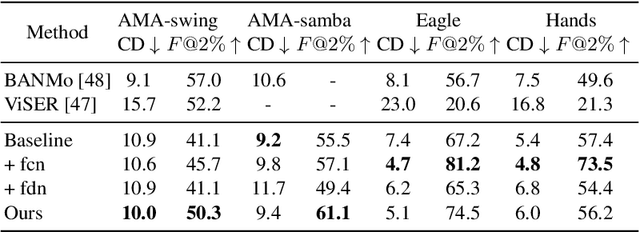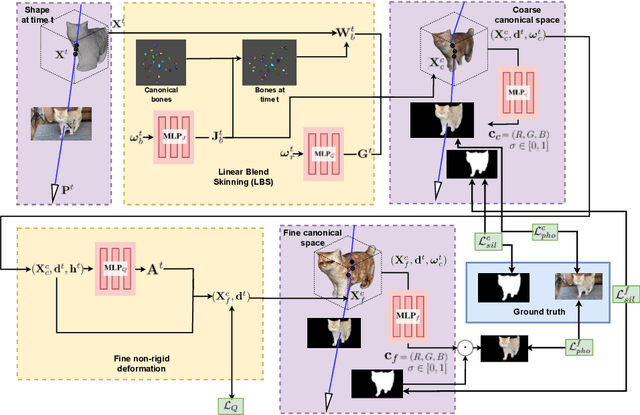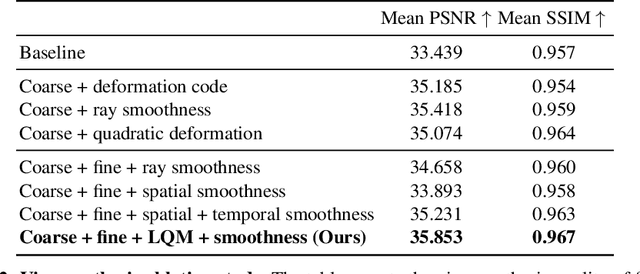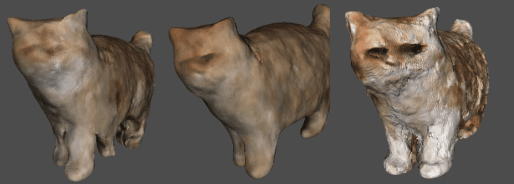Antonio Agudo
Multi-Modal Soccer Scene Analysis with Masked Pre-Training
Dec 22, 2025Abstract:In this work we propose a multi-modal architecture for analyzing soccer scenes from tactical camera footage, with a focus on three core tasks: ball trajectory inference, ball state classification, and ball possessor identification. To this end, our solution integrates three distinct input modalities (player trajectories, player types and image crops of individual players) into a unified framework that processes spatial and temporal dynamics using a cascade of sociotemporal transformer blocks. Unlike prior methods, which rely heavily on accurate ball tracking or handcrafted heuristics, our approach infers the ball trajectory without direct access to its past or future positions, and robustly identifies the ball state and ball possessor under noisy or occluded conditions from real top league matches. We also introduce CropDrop, a modality-specific masking pre-training strategy that prevents over-reliance on image features and encourages the model to rely on cross-modal patterns during pre-training. We show the effectiveness of our approach on a large-scale dataset providing substantial improvements over state-of-the-art baselines in all tasks. Our results highlight the benefits of combining structured and visual cues in a transformer-based architecture, and the importance of realistic masking strategies in multi-modal learning.
JointDiff: Bridging Continuous and Discrete in Multi-Agent Trajectory Generation
Sep 26, 2025Abstract:Generative models often treat continuous data and discrete events as separate processes, creating a gap in modeling complex systems where they interact synchronously. To bridge this gap, we introduce JointDiff, a novel diffusion framework designed to unify these two processes by simultaneously generating continuous spatio-temporal data and synchronous discrete events. We demonstrate its efficacy in the sports domain by simultaneously modeling multi-agent trajectories and key possession events. This joint modeling is validated with non-controllable generation and two novel controllable generation scenarios: weak-possessor-guidance, which offers flexible semantic control over game dynamics through a simple list of intended ball possessors, and text-guidance, which enables fine-grained, language-driven generation. To enable the conditioning with these guidance signals, we introduce CrossGuid, an effective conditioning operation for multi-agent domains. We also share a new unified sports benchmark enhanced with textual descriptions for soccer and football datasets. JointDiff achieves state-of-the-art performance, demonstrating that joint modeling is crucial for building realistic and controllable generative models for interactive systems.
SoccerNet 2025 Challenges Results
Aug 26, 2025Abstract:The SoccerNet 2025 Challenges mark the fifth annual edition of the SoccerNet open benchmarking effort, dedicated to advancing computer vision research in football video understanding. This year's challenges span four vision-based tasks: (1) Team Ball Action Spotting, focused on detecting ball-related actions in football broadcasts and assigning actions to teams; (2) Monocular Depth Estimation, targeting the recovery of scene geometry from single-camera broadcast clips through relative depth estimation for each pixel; (3) Multi-View Foul Recognition, requiring the analysis of multiple synchronized camera views to classify fouls and their severity; and (4) Game State Reconstruction, aimed at localizing and identifying all players from a broadcast video to reconstruct the game state on a 2D top-view of the field. Across all tasks, participants were provided with large-scale annotated datasets, unified evaluation protocols, and strong baselines as starting points. This report presents the results of each challenge, highlights the top-performing solutions, and provides insights into the progress made by the community. The SoccerNet Challenges continue to serve as a driving force for reproducible, open research at the intersection of computer vision, artificial intelligence, and sports. Detailed information about the tasks, challenges, and leaderboards can be found at https://www.soccer-net.org, with baselines and development kits available at https://github.com/SoccerNet.
SoccerNet-v3D: Leveraging Sports Broadcast Replays for 3D Scene Understanding
Apr 14, 2025Abstract:Sports video analysis is a key domain in computer vision, enabling detailed spatial understanding through multi-view correspondences. In this work, we introduce SoccerNet-v3D and ISSIA-3D, two enhanced and scalable datasets designed for 3D scene understanding in soccer broadcast analysis. These datasets extend SoccerNet-v3 and ISSIA by incorporating field-line-based camera calibration and multi-view synchronization, enabling 3D object localization through triangulation. We propose a monocular 3D ball localization task built upon the triangulation of ground-truth 2D ball annotations, along with several calibration and reprojection metrics to assess annotation quality on demand. Additionally, we present a single-image 3D ball localization method as a baseline, leveraging camera calibration and ball size priors to estimate the ball's position from a monocular viewpoint. To further refine 2D annotations, we introduce a bounding box optimization technique that ensures alignment with the 3D scene representation. Our proposed datasets establish new benchmarks for 3D soccer scene understanding, enhancing both spatial and temporal analysis in sports analytics. Finally, we provide code to facilitate access to our annotations and the generation pipelines for the datasets.
Unified Uncertainty-Aware Diffusion for Multi-Agent Trajectory Modeling
Mar 24, 2025Abstract:Multi-agent trajectory modeling has primarily focused on forecasting future states, often overlooking broader tasks like trajectory completion, which are crucial for real-world applications such as correcting tracking data. Existing methods also generally predict agents' states without offering any state-wise measure of uncertainty. Moreover, popular multi-modal sampling methods lack any error probability estimates for each generated scene under the same prior observations, making it difficult to rank the predictions during inference time. We introduce U2Diff, a \textbf{unified} diffusion model designed to handle trajectory completion while providing state-wise \textbf{uncertainty} estimates jointly. This uncertainty estimation is achieved by augmenting the simple denoising loss with the negative log-likelihood of the predicted noise and propagating latent space uncertainty to the real state space. Additionally, we incorporate a Rank Neural Network in post-processing to enable \textbf{error probability} estimation for each generated mode, demonstrating a strong correlation with the error relative to ground truth. Our method outperforms the state-of-the-art solutions in trajectory completion and forecasting across four challenging sports datasets (NBA, Basketball-U, Football-U, Soccer-U), highlighting the effectiveness of uncertainty and error probability estimation. Video at https://youtu.be/ngw4D4eJToE
Dual-Space Augmented Intrinsic-LoRA for Wind Turbine Segmentation
Dec 30, 2024



Abstract:Accurate segmentation of wind turbine blade (WTB) images is critical for effective assessments, as it directly influences the performance of automated damage detection systems. Despite advancements in large universal vision models, these models often underperform in domain-specific tasks like WTB segmentation. To address this, we extend Intrinsic LoRA for image segmentation, and propose a novel dual-space augmentation strategy that integrates both image-level and latent-space augmentations. The image-space augmentation is achieved through linear interpolation between image pairs, while the latent-space augmentation is accomplished by introducing a noise-based latent probabilistic model. Our approach significantly boosts segmentation accuracy, surpassing current state-of-the-art methods in WTB image segmentation.
4DPV: 4D Pet from Videos by Coarse-to-Fine Non-Rigid Radiance Fields
Nov 15, 2024



Abstract:We present a coarse-to-fine neural deformation model to simultaneously recover the camera pose and the 4D reconstruction of an unknown object from multiple RGB sequences in the wild. To that end, our approach does not consider any pre-built 3D template nor 3D training data as well as controlled illumination conditions, and can sort out the problem in a self-supervised manner. Our model exploits canonical and image-variant spaces where both coarse and fine components are considered. We introduce a neural local quadratic model with spatio-temporal consistency to encode fine details that is combined with canonical embeddings in order to establish correspondences across sequences. We thoroughly validate the method on challenging scenarios with complex and real-world deformations, providing both quantitative and qualitative evaluations, an ablation study and a comparison with respect to competing approaches. Our project is available at https://github.com/smontode24/4DPV.
TranSPORTmer: A Holistic Approach to Trajectory Understanding in Multi-Agent Sports
Oct 23, 2024Abstract:Understanding trajectories in multi-agent scenarios requires addressing various tasks, including predicting future movements, imputing missing observations, inferring the status of unseen agents, and classifying different global states. Traditional data-driven approaches often handle these tasks separately with specialized models. We introduce TranSPORTmer, a unified transformer-based framework capable of addressing all these tasks, showcasing its application to the intricate dynamics of multi-agent sports scenarios like soccer and basketball. Using Set Attention Blocks, TranSPORTmer effectively captures temporal dynamics and social interactions in an equivariant manner. The model's tasks are guided by an input mask that conceals missing or yet-to-be-predicted observations. Additionally, we introduce a CLS extra agent to classify states along soccer trajectories, including passes, possessions, uncontrolled states, and out-of-play intervals, contributing to an enhancement in modeling trajectories. Evaluations on soccer and basketball datasets show that TranSPORTmer outperforms state-of-the-art task-specific models in player forecasting, player forecasting-imputation, ball inference, and ball imputation. https://youtu.be/8VtSRm8oGoE
FootBots: A Transformer-based Architecture for Motion Prediction in Soccer
Jun 28, 2024Abstract:Motion prediction in soccer involves capturing complex dynamics from player and ball interactions. We present FootBots, an encoder-decoder transformer-based architecture addressing motion prediction and conditioned motion prediction through equivariance properties. FootBots captures temporal and social dynamics using set attention blocks and multi-attention block decoder. Our evaluation utilizes two datasets: a real soccer dataset and a tailored synthetic one. Insights from the synthetic dataset highlight the effectiveness of FootBots' social attention mechanism and the significance of conditioned motion prediction. Empirical results on real soccer data demonstrate that FootBots outperforms baselines in motion prediction and excels in conditioned tasks, such as predicting the players based on the ball position, predicting the offensive (defensive) team based on the ball and the defensive (offensive) team, and predicting the ball position based on all players. Our evaluation connects quantitative and qualitative findings. https://youtu.be/9kaEkfzG3L8
Generalized Nested Latent Variable Models for Lossy Coding applied to Wind Turbine Scenarios
Jun 10, 2024



Abstract:Rate-distortion optimization through neural networks has accomplished competitive results in compression efficiency and image quality. This learning-based approach seeks to minimize the compromise between compression rate and reconstructed image quality by automatically extracting and retaining crucial information, while discarding less critical details. A successful technique consists in introducing a deep hyperprior that operates within a 2-level nested latent variable model, enhancing compression by capturing complex data dependencies. This paper extends this concept by designing a generalized L-level nested generative model with a Markov chain structure. We demonstrate as L increases that a trainable prior is detrimental and explore a common dimensionality along the distinct latent variables to boost compression performance. As this structured framework can represent autoregressive coders, we outperform the hyperprior model and achieve state-of-the-art performance while reducing substantially the computational cost. Our experimental evaluation is performed on wind turbine scenarios to study its application on visual inspections
 Add to Chrome
Add to Chrome Add to Firefox
Add to Firefox Add to Edge
Add to Edge